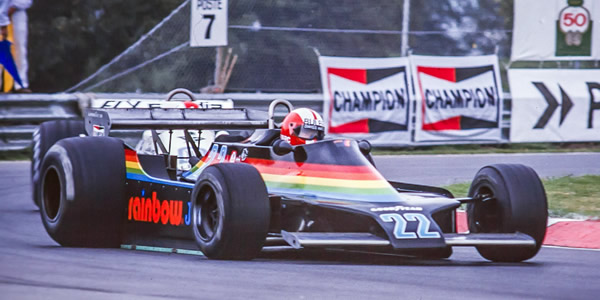Ensign N179 car-by-car histories

Marc Surer in the Ensign N179 at the Canadian Grand Prix at Montréal in 1979. Copyright Bruce Stewart 2017. Used with permission.
After four seasons using Dave Baldwin's elegant N175-N177 designs, Mo Nunn attempted a completely new wing car design for 1979. It was not a success.
As the new ground-effect F1 designs appeared at the start of the 1979 season, it was clear that most designers had studied the Lotus 79 and aimed to copy it or improve on it. Almost all followed the template of a narrow monocoque with a single fuel cell behind the driver and the main radiators inside wide ground-effect sidepods. The Ensign N179, designed by Mo Nunn assisted by ex-Surtees engineer Shahab Ahmed, was the most striking departure to this pattern. It had a monocoque wider than its rivals, and instead of putting the radiators in the sidepods, it had both water and oil radiators on the nose, reaching right up to the top of the scuttle. The N179 was a corollary to the old maxim that if it looks good, it is good. This looked terrible, and was terrible. After its debut at the South African GP, it was significantly revamped, with the radiators moved into the sidepods, but the real problem was the lack of any real ground effect - when Derek Daly tried the car without skirts, the handling was unchanged.
Daly failed to qualify on four out of his five attempts in the N179, and was the slowest car by nearly a second at Long Beach, where a lack of healthy cars meant he was allowed to start. Daly left the team the team after Monaco, saying he would concentrate on F2, but he had one eye on the vacancy at Ligier after Patrick Depailler's hang-gliding accident. Tiff Needell was chosen to replace Daly for the rest of the season, making him momentarily the only Englishman in F1 after James Hunt's retirement, but FISA turned down his "Super Licence" application. The Ensign drive then went to promising French F2 Chevron pilot Patrick Gaillard. He was well off the qualifying pace at Dijon but crept onto the back row of the grid at the British GP for his GP debut and plodded round at the back to finish 13th, the car's only finish of the season. He had three more GPs with the team but only qualified once more, in Austria, where he ran last again until the suspension broke. For Monza, Nunn replaced the Frenchman with Marc Surer, the new F2 champion. He could not manage enough track time to qualify the Ensign for this event and also missed out in Canada before making his GP debut at Watkins Glen, where he qualified 21st out of 30 runners and retired at half distance. The car carried Rainbow Jeans colours for these two races.
Race
Starts
Prix
Starts
Prix
Wins
The old N179 was pushed into a corner and there it stayed until Nunn's deal with Bobby Howlings in April 1981 to sell all the team's old stock. After being restored by Neil Edwards, the car was sold to the owner of Rainbow Jeans. If reports are to be believed, he had it installed in his New York penthouse - by helicopter! It was sold off later that decade and returned to England, where it was used in historic racing in the late 1990s. A couple of owners later, it was still racing in historic events in 2023. A second N179 was started by Ensign and that car also passed to Howlings, who sold it through the trade. It appeared in Formule Libre in the 1980s and was then sold to the US, where it has been used in historic racing for many years.
These histories were last updated on .